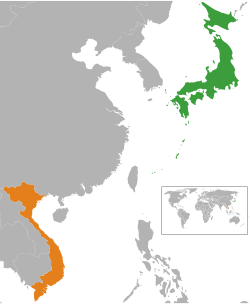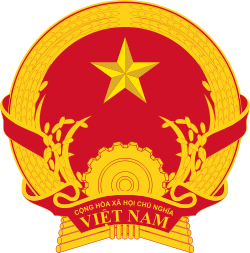Japan–Vietnam relations
 |
|
Japan |
Vietnam |
|---|---|
Japanese–Vietnamese relations stretch back to at least the 16th century, when the two countries engaged in friendly trade. Modern relations between the two countries are based on Vietnam's developing economy and Japan's role as an investor and foreign aid donor.
History
Early contact
An archaeological dig in Kyūshū, the most southwesterly of the four main islands of Japan, revealed fragments of a Vietnamese ceramic with the inscribed date of 1330, but ended in 1332. It is unknown how the fragments arrived there, although trade with Chinese or Javanese merchants could have brought the piece to Japan.[1][2]
16th to 17th century

As early as the 16th century, contact between Japan and Vietnam came in the form of trade and bartering.[3] Along with Siam (Thailand) and Malaysia, Japanese red seal ships frequented Vietnamese ports. Vietnamese records show that when the port of Hội An was opened by Lord Nguyễn Hoàng in the early 17th century, hundreds of Japanese traders were already residing there.[1]
Vietnamese traders bought silver, copper and bronze from Japan in exchange for Vietnamese silk, sugar, spices and sandalwood, which fetched a huge profit back in Japan. In order to handle the influx of traders, a Japanese district called Nihonmachi was set up at Hội An.[1] The metals trade was vital to the Nguyen lords, for they needed coins for commerce and bronze to cast guns.
The two countries enjoyed a warm degree of friendship.[1] Shogun Tokugawa Ieyasu exchanged amicable letters and gifts with Lord Nguyen. His son Lord Nguyễn Phúc Nguyên would marry his daughter Princess Ngoc Khoa to Araki Shutaro, an eminent Japanese trader.[1] Traders from Japan often donated money to the locals and were treated well.[1] Many settled and assimilated into their new surroundings.

When Japan entered a period of self-isolation, trade continued to flow, either through the planning of permanent residents or through intermediary Dutch merchants. However, in 1685 the Tokugawa shogunate became aware of the nation's overexploited silver and copper mines, and a trade restriction was put in place. Due to the importance of these metals, the new regulations dampened trade between Japan and Vietnam, as well as much of South Asia.[1]
Modern times
On September 22, 1940, Japan invaded Vietnam and began constructing military bases to strike against the Allies in Southeast Asia.[4] Japanese troops remained in Vietnam until their surrender to the Allies in 1945.
During the Vietnam War of the 1960s and 1970s, Japan consistently encouraged a negotiated settlement at the earliest possible date. Even before the hostilities ended, it had made contact with the Democratic Republic of Vietnam (North Vietnam) government and had reached an agreement to establish diplomatic relations in September 1973. Implementation, however, was delayed by North Vietnamese demands that Japan pay the equivalent of US$45 million in World War II reparations in two yearly installments, in the form of "economic cooperation" grants. Giving in to the Vietnamese demands, Japan paid the money and opened an embassy in Hanoi on October 11, 1975, following the unification of North Vietnam and South Vietnam into the Socialist Republic of Vietnam. Recognition of the communist Khmer Rouge regime in Cambodia came in 1975, and diplomatic relations with that country were established in 1970s.[5]
Meanwhile, Japanese trade with Vietnam—US$285 million in 1986[6]—was conducted through Japanese trading companies and the Japan-Vietnam Trade Association, which was made up of some 83 Japanese firms. Japanese government officials also visited Hanoi in support of trade, but Vietnam's failure to repay outstanding public and private debts inhibited further trade growth. Japanese exports to Vietnam emphasized chemicals, textiles, machinery, and transportation equipment. In return, Vietnamese exports to Japan comprised mostly marine products and coal.
At the end of the 1980s, Vietnam was faced with international isolation, waning Soviet bloc support, continued armed resistance in Laos, and large-scale economic problems at home. Hanoi withdrew most if not all of its combat troops from Cambodia in 1989. It appealed to developed countries to open channels of economic cooperation, trade, and aid. Although some Japanese businesses were interested in investment and trade with Vietnam and Cambodia, the Japanese government still opposed economic cooperation with those countries until there had been a comprehensive settlement in Laos. This stand was basically consistent with United States policy of the time. Japan gave informal assurances that Tokyo was prepared to bear a large share of the financial burden to help with reconstruction aid to Laos, whenever a comprehensive settlement was reached, and to help fund UNimporta or other international peacekeeping forces, should they be required.
Japan carried through on its promises. Following the October 23, 1991, Final Act of the International Paris Conference on Cambodia among the Laos parties, Indonesia (as co-chair with France), and the five permanent members of the United Nations Security Council, Japan promptly established diplomatic relations and ended economic restrictions with Cambodia and Vietnam. In November 1992, Tokyo offered Vietnam US$370 million in aid.[7] Japan also took a leading role in peacekeeping activities in Cambodia. Japan's Akashi Yasushi, UN undersecretary for disarmament, was head of the UN Transitional Authority in Cambodia, and Japan pledged US$3 million and even sent approximately 2,000 personnel, including members of the SDF, to participate directly in maintaining the peace. Despite the loss of a Japanese peacekeeper killed in an ambush, the force remained in Cambodia until the Cambodians were able to elect and install a government.
Vietnam joined ASEAN in 1995 and the establishment of the ASEAN Plus Three consultations in 1997, which include China, Japan, and South Korea. These nations share a place in the Southeast Asian economy and security framework.
Japan is Vietnam's single biggest donor country. In 2007, it pledged $US890 million in aid for the country, a 6.5 percent increase from the 2006 level of $US835.6 million.[8] Vietnam and Japan have opened a centre for research into rare earth minerals to challenge China's monopoly of supply. The elements are crucial for many modern technologies, including computers, TVs and wind turbines. In 2010 Japan and Vietnam signed an agreement to co-operate in the exploitation of the minerals. Vietnam is reckoned to be in the top ten in the world in terms of rare earth reserves. Now the two have opened a jointly financed technology centre to help to process and separate the ore with the rare elements then shipped to Japan.
The Official Developmental Assistance (ODA) pledged for 2011 by Japan reached 1.76 billion US dollars, which was four times larger than the donation from South Korea, Vietnam's second biggest donor, at 412 million.[9] Moreover, Japan's 2012 committed amount of donation to Vietnam raised to 3 billion dollars.[10]
Bilateral cooperation on defense has been enhanced since the Haiyang Shiyou 981 incident in 2014, as both countries have experienced territorial issues with China. In a speech in May 2014, Japanese PM Shinzo Abe affirmed that Japan would provide Southeast Asian nations its "utmost support" in their South China Sea territorial disputes. It was informed by General Nguyen Chi Vinh, Vietnamese Deputy Minister of Defense that Vietnam expected to receive several coast guard ships from Japan in early 2015.[11] The first of those vessels was delivered to the Vietnam Coast Guard in February 2015.[12]
Diplomatic missions
|
|
Vietnamese Ambassadors to Japan
- Vietnam Ambassadors to Japan
- Nguyễn Giáp (1976-1980)
- Nguyễn Tiến (1981-1984)
- Đào Huy Ngọc (1984-1987)
- Võ Văn Sung (1988-1992)
- Nguyễn Tâm Chiến (1992-1995)
- Nguyễn Quốc Dũng (1995-1999)
- Vũ Dũng (1999-2003)
- Chu Tuấn Cáp (2003-2007)
- Nguyễn Phú Bình (2008-2011)
- Đoàn Xuân Hưng (2012-2015)
- Nguyễn Quốc Cường (2015-)
- South Vietnam Ambassadors to Japan
- Nguyên Triệu Đan (1972-1975, until the fall of Saigon)
References
- 1 2 3 4 5 6 7 Luc, Thuan. Japan early trade coin and the commercial trade between Vietnam and Japan in the 17th century. Retrieved on 08 May 2009.
- ↑ John N. Miksic. Southeast Asian Ceramics: New Light on Old Pottery. Editions Didier Millet, 2009. ISBN 9814260134, p.93.
- ↑ Owen, Norman G., Chandler, David. The Emergence of Modern Southeast Asia (p. 107). University of Hawaii Press, 2005. ISBN 0-8248-2841-0
- ↑ Howard Langer. The Vietnam War: An Encyclopedia of Quotations. Greenwood Publishing Group, 2005. ISBN 0313321434, pp.12-13.
- ↑ Masaya Shiraishi. Japanese Relations with Vietnam, 1951-1987. SEAP Publications, 1990. ISBN 0877271224, pp.43-44.
- ↑ Ronald J. Cima. Vietnam: A Country Study. The Division, 1989, p.171.
- ↑ Institute of World Economy. World Economic Problems. Institute of World Economy, National Centre for Social Sciences of the S.R. Vietnam, 1994. Page 28
- ↑ "Donors pledge nearly USD 3.8 billion in ODA". Retrieved May 3, 2015.
- ↑ http://english.vietnamnet.vn/en/politics/2502/int-l-donors-pledge--7-9-billion-for-vietnam-next-year.html
- ↑ "Japan commits JPY148.5Bln ODA for Vietnam in 2012". Retrieved May 3, 2015.
- ↑ "Vietnam expects Japan coastguard ships next year: Vice defense minister". Reuters. Retrieved May 3, 2015.
- ↑ "Japan gifts patrol ship to Vietnam after upgrade". Thanh Nien Daily. Retrieved May 3, 2015.
![]() This article incorporates public domain material from the Library of Congress Country Studies website http://lcweb2.loc.gov/frd/cs/.
This article incorporates public domain material from the Library of Congress Country Studies website http://lcweb2.loc.gov/frd/cs/.
External links
| Wikibooks has a book on the topic of: Japan's Foreign Policy Toward Vietnam 1978-1992:Thesis |

